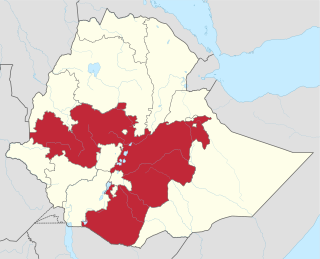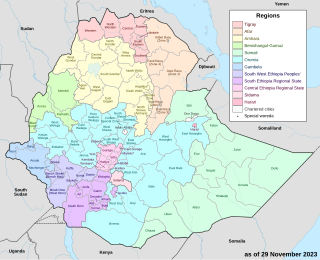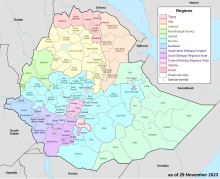Demographics
Based on the 2007 Census conducted by the Central Statistical Agency of Ethiopia (CSA), this Zone has a total population of 2,723,850, an increase of 48.79% over the 1994 census, of whom 1,383,198 are men and 1,340,652 women; with an area of 17,935.40 square kilometers, East Hararge has a population density of 151.87. While 216,943 or 8.27% are urban inhabitants, a further 30,215 or 1.11% are pastoralists. A total of 580,735 households were counted in this Zone, which results in an average of 4.69 persons to a household, and 560,223 housing units. The two largest ethnic groups reported were the Oromo ((96.43%) and the Amhara (2.26%); all other ethnic groups made up 1.31% of the population. Oromo was spoken as a first language by 97.6%,and the remaining 2.4% spoke all other primary languages reported. The majority of the inhabitants were Muslim, with 96.51% of the population having reported they practiced that belief, while 3.12% of the population professed Ethiopian Orthodox Christianity. [2]
The 1994 national census reported a total population for this Zone of 1,830,631 in 346,117 households, of whom 933,677 were men and 896,954 women; 98,012 or 5.35% of its population were urban dwellers at the time. [3] (This total also includes an estimate for the inhabitants of 86 rural kebeles and one urban one, which were not counted; they were estimated to have 224,057 inhabitants, of whom 112,831 were men and 111,226 were women. [4] ) The three largest ethnic groups reported in East Hararge were the Oromo (93.69%), the Amhara (4.16%), and the Somali (1.84%); all other ethnic groups made up 0.31% of the population. Oromiffa was spoken as a first language by 92.57%, 4.02% spoke Amharic, and 3.05% spoke Somali; the remaining 0.36% spoke all other primary languages reported. The majority of the inhabitants were Muslim, with 95.28% of the population having reported they practiced that belief, while 4.51% professed Ethiopian Orthodox Christianity. [3]
According to a May 24, 2004 World Bank memorandum, 3% of the inhabitants of East Harerge have access to electricity, this zone has a road density of 39.6 kilometers per 1000 square kilometers (compared to the national average of 30 kilometers), [5] the average rural household has 0.5 hectare of land (compared to the national average of 1.01 hectare of land and an average of 1.14 for the Oromia Region) [6] and the equivalent of 0.6 heads of livestock. 13% of the population is in non-farm related jobs, compared to the national average of 25% and a Regional average of 24%. Concerning education, 53% of all eligible children are enrolled in primary school, and 10% in secondary schools. Concerning health, 44% of the zone is exposed to malaria, and none to Tsetse fly. The memorandum gave this zone a drought risk rating of 367. [7]

Oromia is a regional state in Ethiopia and the homeland of the Oromo people. Under Article 49 of Ethiopian Constitution, the capital of Oromia is Addis Ababa, also called Finfinne. The provision of the article maintains special interest of Oromia by utilizing social services and natural resources of Addis Ababa.

Arsi is a zone in Oromia Region of Ethiopia, named after a clan of the Oromo, who inhabit in the area.

Bale Zone is a zone in Oromia Region of Ethiopia. Bale is bordered on the south by the Ganale Dorya River which separates it from Guji Zone, on the west by the West Arsi Zone, on the north by Arsi Zone, on the northeast by the Shebelle River which separates it from West Hararghe Zone and East Hararghe Zone, and on the east by the Somali Region.

East Welega is one of the zones in the central Oromia Region of Ethiopia. This administrative division acquired its name from the former province of Welega. Towns and cities in this zone include Nekemte.

West Wollega Zone is a zone in the western part of Oromia Region, Ethiopia. This zone is named after the former province of Wollega, whose western part lay in the area West Wollega now occupies.

West Hararge is a zone in the Oromia Region of Ethiopia. West Hararghe takes its name from the former province of Hararghe. West Harerge is bordered on the south by the Shebelle River which separates it from Bale, on the southwest by Arsi, on the northwest by the Afar Region, on the north by the Somali Region and on the east by East Hararghe. Towns in West Hararghe include Chiro, Badessa, Gelemso, and Mieso, Asebot.
Doba is a woreda in Oromia Region, Ethiopia. It is named after its major town Doba. Part of the West Haraghe, Doba is bordered on the south by Chiro, on the west by Mieso, on the north by the Somali Region, on the east by the East Hararghe, and on the southeast by Tulo.
Tulo is one of the Aanaas in Oromia Regional State of Ethiopia. Part of the West Hararghe Zone, Tulo is bordered on to the north by Doba, to the south by Masela, to the east by the East haraghe Zone, and to the west by Nannawa Chiro. Towns in Tulo include Debeso and Hirna.
Guba Koricha is a Aanaa in Oromia Regional State, Ethiopia. Located in the West Hararghe Zone, Guba Koricha, according to the OCHA map (2005) is bordered on the south by Darolebu, on the southwest by the Arsi Zone, on the west by the Afar Region, on the north by Mieso, on the northeast by Chiro, on the east by Habro, and on the southeast by Boke. Woreda of Anchar was separated from Guba Koricha.
Habro is one of the Aanaas in the Oromia of Ethiopia. It is named after the former Aanaa of the same name. Part of the West Hararghe Zone, the district is bordered on the south by Darolebu, on the west and north by Guba Koricha, on the northeast by Kuni, and on the southeast by Boke. Towns in Habro include Belbelti, Gelemso and Wachu.
Daru labu is a woreda in the Oromia Region of Ethiopia. Located in the West Hararghe Zone, Daru labu is bordered on the south by the Shebelle River which separates it from the Bale Zone, on the west by the Arsi Zone, on the northwest by Guba Koricha, on the north by the Habro, and on the east by Boke. Towns in Darolebu include Mechara and Micheta.
Kuni is one of the Aanaas in the Oromia Regional State of Ethiopia. Part of the West Hararghe Zone, Kuni is bordered on the south by Boke, on the west by Habro, on the northeast by Chiro, and on the east by the Galetti River, which separates it from the East Hararghe Zone.
Kombolcha is a woreda in Oromia Region, Ethiopia. Part of the East Hararghe Zone, Kombolcha is bordered on the south by the Harari Region, on the southwest by Haro Maya, on the northwest by Dire Dawa, on the north by the Somali Region, and on the east by Jarso. The administrative center of the woreda is Melka Rafu.
Gursum is one of the Districts in the Oromia region of Ethiopia. Part of the East Hararghe Zone, Gursum is bordered on the south by Babille, on the west by the Harari Region, on the north by Jarso, and on the east by the Gursum district in the Somali region. The administrative center of the woreda is Funyan Bira.
Babile is one of the districts in the East Hararghe Zone of Oromia Region in Ethiopia. Part of the East Hararghe Zone, Babile is bordered on the south and east by the Babile district of the Somali Region, on the west by Fedis and the Harari Region, and on the north by Gursum; the Fafen River defines a portion of Babille's eastern border. The administrative center of this woreda is Babille Town. Other key towns of this district include Bisidimo and many kebeles.Karanle
Fedis is a woreda in Oromia Region, Ethiopia. Part of the East Hararghe Zone, Fedis is bordered on the southwest by Garamulleta zone, Meyumuluke woreda, on the west by Girawa, on the northwest by Haro Maya, on the north by the Harari Region, on the east by Babille, and on the southeast by the Erer River which separates it from the Somali Region at south by Midega tola district. The administrative center of this district is Boko.
Haramaya is one of the woreda in the East Hararghe zone, Oromia Region, Ethiopia. It is named from the Haramaya lake that found in the woreda. The word Haramaya is come from two Oromo language word's[Hara and Maya] Hara means Lake and maya means name of person so Haramaya means the 'lake of maya'. Haramaya is bordered on the south by Kurfa Chele, on the west by Kersa, on the north by Dire Dawa, on the east by Kombolcha, and on the southeast by the Harari Region. The woreda has 33 rural keble and 4 administrative towns. Towns include Haramaya, Addele, Aweday and sharif kaled.
Meta is one of the districts in the Oromia of Ethiopia. Part of the East Hararghe Zone, Meta is bordered on the southwest by Deder, on the northwest by Goro Gutu, on the north by the Somali Region, on the northeast by Kersa, and on the southeast by Bedeno. Towns in Meta include Chelenqo and Kulubi.
Goro Gutu is a Aanaa in Oromia, Ethiopia. This district is named after Mount Goro Gutu, its tallest mountain. Part of the East Hararghe Zone, Goro Gutu is bordered on the south by Deder, on the west by the West Hararghe Zone, on the north by the Somali Region, and on the east by Meta. The administrative center is ; Karamile other towns include Boroda towns
Gola Oda is a District in Oromia, Ethiopia. It was part of former Gola Odana Meyumuluke district what was divided for Gola Oda and Meyumuluke districts. Part of the East Hararghe Zone, Gola Odana Meyumuluke is bordered on the south by the Shebelle River which separates it from the Bale Zone, on the southwest by the Galetti River which separates it from the West Hararghe Zone, on the northwest by Malka Balo, on the north by Bedeno, on the northeast by Girawa, on the east by Fedis, and on the southeast by the Erer River which separates it from the Somali Region. The administrative center of this woreda is Burka.



